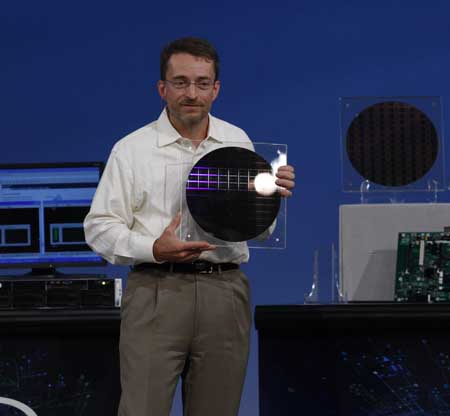The news on Intel's Nehalem; chips with integrated GPUs up next

Intel has given new details of what it calls the biggest change in its processor platform in a decade.
The new information on Nehalem, discussed in keynotes and presentations at the Intel Developer Forum this week, was expected. Nehalem isn't a single product, but a family of products all based on a new microarchitecture. The first products, due to ship in the fourth quarter, will be performance and "extreme" desktop chips bearing the name Core i7. Nehalem will also be used in processors with four cores for servers and workstations (Nehalem-EP), followed by mobile processors for laptops. In his keynote, senior vice president Pat Gelsinger first showed a silicon wafer of Nehalem-EX processors each with eight cores scheduled for the second half of 2009.
Intel didn't provide much in the way of performance comparisons for Nehalem, partly because it is not a single product, but also, I suspect, because it is saving the numbers for the launch of the Core i7 chips. In general terms, the goal of Nehalem was to increase system performance, while using about the same or less power than the current Core 2 and Xeon platforms. "High performance and energy efficiency are not mutually exclusive. They may sound mutually exclusive but if you innovate enough, it is possible," said Rajesh Kumar, an Intel fellow in a separate Nehalem presentation. "We want to give you a racecar that gives you the miles per gallon of an economy car."
The changes to the memory architecture in Nehalem are well-known at this point. It has a memory controller integrated on the die and uses a new interface, Quick Path Interconnect or QPI, which links the cores to one another and to the I/O hub, or Southbridge. (The Northbridge, a memory controller that was part of a separate chipset, and the Front Side Bus are headed for the Computer History Museum.) Nehalem also uses DDR3 memory, which operates at higher frequencies (1,066MHz initially) and at lower voltage, which saves power. All of these changes boost system bandwidth (by 3.4 times, according to an Intel presentation) and decrease latency, the time it takes for a processor to retrieve information from memory. AMD is quick to point out that it has had many of these features in its processors for years.
The cache also has a big impact on system latency, and this is becoming a bigger problem in systems with four or eight cores, each of which in the case of Nehalem can process two instructions simultaneously (multi-threading). To address this, Nehalem adds a third level of cache. Intel also made some lower level changes to the cache--new error correction algorithms, independent power control and the use of low-voltage 8-T SRAM in place of the usual 6-T SRAM--so that the entire system can operate at lower voltages without running into memory errors.
The power management features of Nehalem were not as well known until now. Nehalem's turbo mode can automatically turn cores on and off depending on the workload. This happens at a low level so it is invisible to the operating system and user. Intel says this will provide optimal performance with both single-threaded applications--by shifting all the power to a single core--and on highly multi-threaded applications which can take advantage of four or even eight cores with two threads each.
To make turbo mode work, Intel said it designed "new transistors and silicon technology" so that a power gate at each core can shut down power completely, and added a Power Control Unit--a separate microcontroller with more than 1 million transistors of its own--to control the gates. In a not-so-subtle knock at competitor AMD and its "asset-smart" plans, Kumar said the new power management features showed why close cooperation between process technology engineers and chip designers was so important in advanced microprocessors.
Intel also dropped some hints about how the technology in Nehalem will be used in other products, most notably processors that have both general-purpose x86 cores and GPUs on the same silicon die. For example, the QPI can be used to connect the CPUs to the GPUs and turbo mode can be extended to control the GPUs as well, so that you can have any combination of x86 cores and GPUs running depending on the applications you are using. There will be both desktop (Havendale) and mobile (Auburndale) processors with GPUs onboard; the desktop and laptop versions without integrated graphics are code-named Lynnfield and Clarksfield, respectively. These are all due in the second half of 2009.
AMD has its own version of this CPU-GPU tandem, which it refers to as Fusion, though initial versions will put the CPU and GPU in the same overall package, but not on the same physical piece of silicon.
